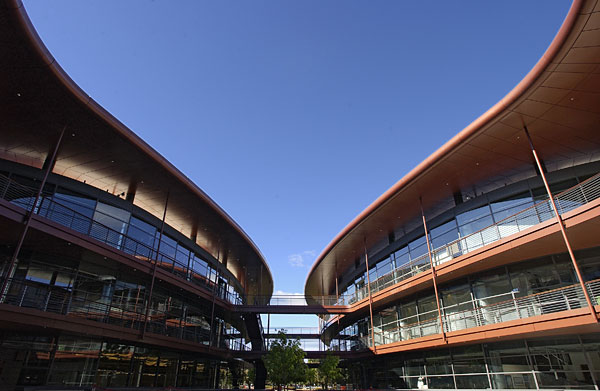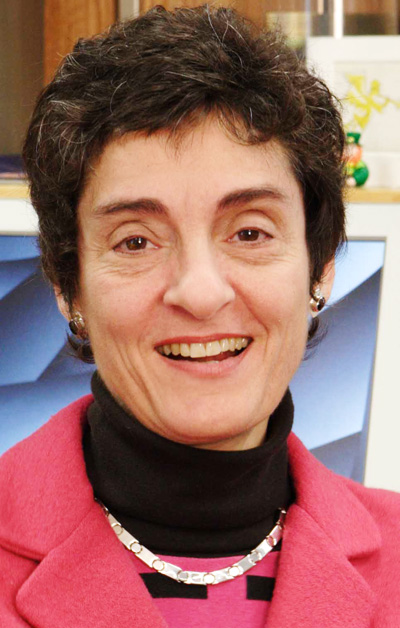Hennessy appoints Harvard scientist to lead Bio-X program
President John Hennessy has named Carla Shatz, the head of Harvard's neurobiology department, to lead the next phase of Stanford's Bio-X program, the landmark bioscience research effort that promotes interdisciplinary collaborations among life scientists, medical scientists, engineers, physicists and computer scientists.
Shatz, the Nathan Marsh Pusey Professor of Neurobiology and chair of the Department of Neurobiology at Harvard Medical School, was a professor at the Stanford School of Medicine from 1978 to 1991. She will succeed Matthew Scott, who spent the last five years launching the program. Scott will be returning to full-time research and his work as co-chair of Stanford's Center for Children's Brain Tumors.
"Carla Shatz brings a truly remarkable blend of talents to this task," Hennessy said. "She has the mindset of a groundbreaking scientist, the skills of a bold and resourceful leader and a passion for research on the frontiers of knowledge. These skills alone would qualify her to lead Bio-X. When one adds her many years of experience at Stanford to the mix, it seems impossible to imagine a person who is more ready and able to lead a program of such critical importance to the university."
Shatz, who will return to Stanford during the summer, said she was "thrilled to have the opportunity" to direct the program.
"This is where the future of biomedical research is going—working at the interface of quantitative science, physics, engineering and biology," she said. "In addition to facilitating the growth of Bio-X, I'm excited about participating directly through the work in my own laboratory."
Vice Provost Ann Arvin, calling Shatz the "ideal candidate," cited her proven leadership skills in developing innovative research programs, her pioneering basic science work on the relationship between brain development and the immune system and her experience breaking new ground for women in science.
What's more, Arvin said, Shatz brings an outsider's fresh perspective to Bio-X while also being intimately familiar with Stanford, noting that she and Shatz were appointed assistant professors on the same day. Shatz has, in her own words, "a zillion friends" still on the campus. "Carla has deep roots here, and it is a pleasure to welcome her back," Arvin said. "She is an absolutely stellar leader and one of the foremost investigators in the field of neuroscience."
Shatz will assume the helm of Bio-X as it enters the next stage of its development. Much of the first five years was devoted to getting the program's flagship new building, the James H. Clark Center, up and running. Over that period, a diverse group of faculty has moved into the new quarters—almost all of the laboratory space there has been assigned to more than 600 researchers from some 25 departments. Scott, the current chief, has worked out the physical, financial and social complexities involved in establishing this new multidisciplinary community. At the same time, Bio-X fellowship and seed grant programs have been powerful incentives for new interdisciplinary collaborations among many of the 330 Stanford faculty, in 50 departments, who are Bio-X affiliates.
Shatz will be able to pay greater attention to integrating Bio-X into the campus at large and to focus on specific scientific initiatives, said Scott, who is a professor of developmental biology, of genetics and of bioengineering. It also will allow her to focus on increasing the involvement of researchers beyond the Clark Center and deepening Bio-X ties with more departments, as well as developing new training programs and new curricula and increasing outreach to students and postdoctoral scholars, he said.
"Carla has already been thinking in great detail about how to promote interdisciplinary work more widely at Stanford," Scott added. "Helping to bring her here to take the next step may be the best thing I've ever done for Bio-X."
This would not be the first time that Shatz has taken a strong research program and made it even stronger. She is credited with making Harvard's neurobiology department into "one capable of leading the entire field of neuroscience in bold new directions," with "incredibly rich and diverse research," according to the announcement of her move from Joseph Martin, dean of the Harvard Medical School. She was successful in mentoring, recruiting and promoting a number of talented young researchers to the faculty, including six women.
Shatz herself has been a pioneer among women in the biosciences. The Harvard Medical Alumni Bulletin recently reported that in 1976 she became the first woman to receive a doctorate in neurobiology from Harvard; she later became one of the first female junior faculty and one of the first tenured women in basic sciences at the Stanford School of Medicine. In 2000, she became the first woman to chair Harvard's neurobiology department—and only the second woman in the history of Harvard Medical School to chair a basic science department.
Shatz's research has advanced the understanding of how the eye and the brain become properly connected during early life. She was the first to observe how, during fetal development, the eye tested its connections to the brain's visual processing regions by sending and resending waves of electrical activity through nerve cells across the retina.
Shatz also overturned the long-held view in neuroscience of "immune privilege," the theory that the brain operates in isolation from the immune system. Although the scientific community initially greeted with skepticism her report of a molecule in the immune system that was affecting brain development, she did not waver in the face of criticism and her position ultimately prevailed.
"Carla Shatz's experience in leadership of the neurobiology department at Harvard has given her a broad view of the role of research in human health," said Sharon Long, dean of the School of Humanities and Sciences, who along with Arvin and Scott serves on the Bio-X executive committee. "At the same time, her own work addresses truly fundamental scientific questions, and she has a deep understanding of how to nurture basic research excellence. Her energy and imagination, along with her experience, make her an ideal new leader for the Bio-X community at Stanford."
Philip Pizzo, dean of the School of Medicine and another member of the Bio-X executive committee, added that Shatz has been serving for several years on the school's national advisory council and praised "her broad fund of knowledge, her critical judgment, her passion for facilitating interdisciplinary research and education, and her long-standing commitment to mentorship and career development, particularly for women."
Shatz is a member of the National Academy of Sciences, the Institute of Medicine of the National Academies and the American Philosophical Society.



Share This Story